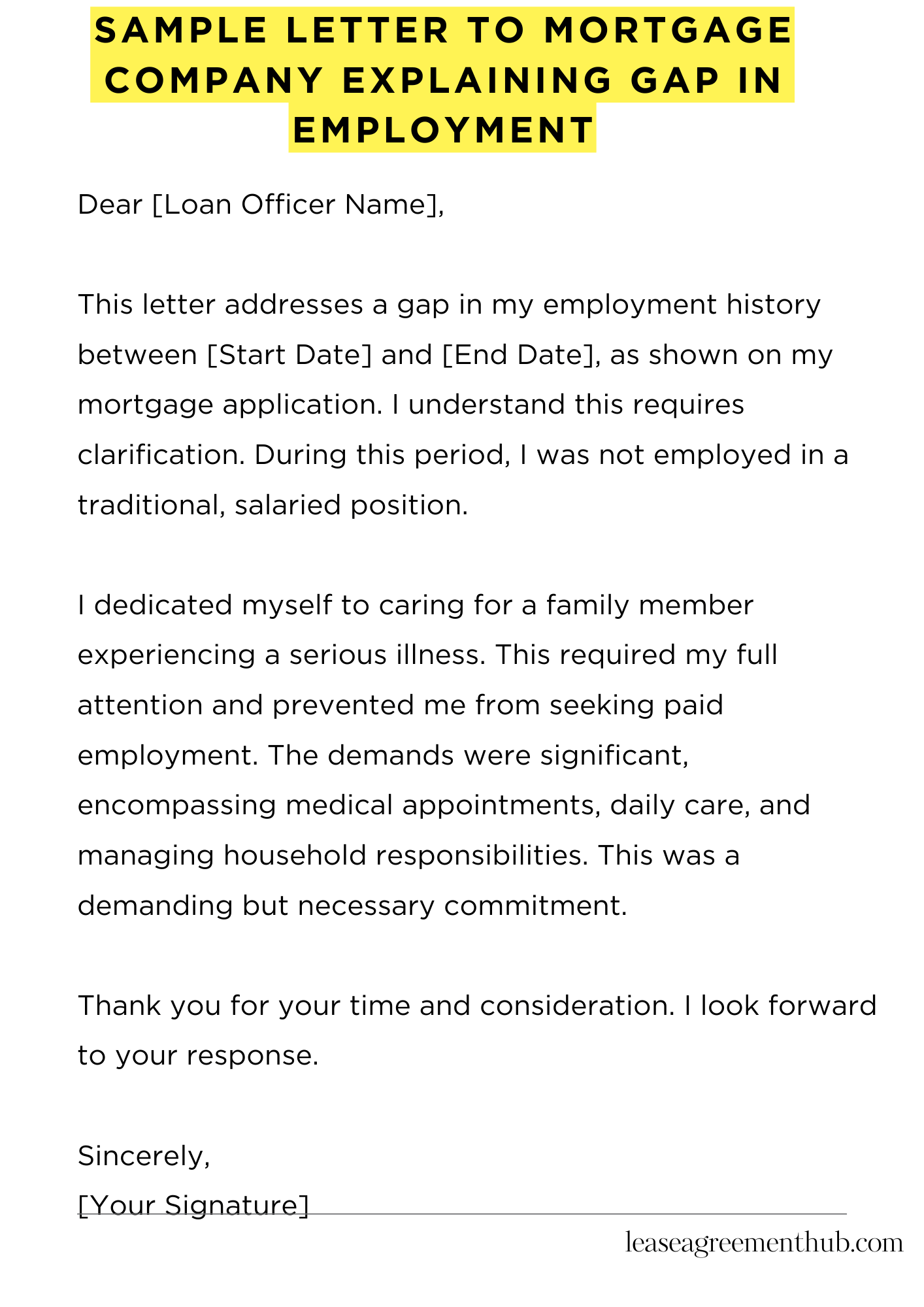Finding a new home is exciting. Getting a mortgage can be tricky. A gap in your employment history can be a problem. This letter helps explain that gap.
This article gives you example letters. These samples help you write your own letter. They show you how to explain your employment history clearly.
Use our examples. They make writing your letter easier. You’ll feel more confident applying for your mortgage.
sample letter to mortgage company explaining gap in employment
[Your Name]
[Your Address]
[Your Phone Number]
[Your Email Address]
[Date]
[Mortgage Company Name]
[Mortgage Company Address]
Dear [Loan Officer Name],
This letter addresses a gap in my employment history between [Start Date] and [End Date], as shown on my mortgage application. I understand this requires clarification. During this period, I was not employed in a traditional, salaried position.
I dedicated myself to caring for a family member experiencing a serious illness. This required my full attention and prevented me from seeking paid employment. The demands were significant, encompassing medical appointments, daily care, and managing household responsibilities. This was a demanding but necessary commitment.
My financial records, including bank statements and tax returns, reflect my income during this time, primarily from savings and support from family. I am happy to provide any additional documentation you require to demonstrate my financial stability. I am confident that my current employment, at [Your Current Employer] since [Start Date], demonstrates my commitment to financial responsibility. My income is sufficient to meet my mortgage obligations.
Thank you for your time and consideration. I look forward to your response.
Sincerely,
[Your Signature]

How to Write a Sample Letter to Mortgage Company Explaining Gap in Employment
Understanding the Necessity of a Gap Explanation
A lacuna in your employment history can raise concerns for mortgage lenders. It’s essential to proactively address this gap. Providing a clear, concise explanation demonstrates financial responsibility and transparency. This can significantly impact your loan application’s success. Don’t let a momentary lapse in employment jeopardize your homeownership dreams.
Gathering Pertinent Documentation
Before drafting your letter, collate all relevant documentation. This could include termination letters, severance agreements, medical records, or documentation of any extenuating circumstances. Solid evidence bolsters your narrative and reinforces your credibility. This meticulous preparation demonstrates your commitment to securing the mortgage.
Structuring Your Letter for Maximum Impact
Begin with a formal salutation, addressing the appropriate loan officer. Succinctly state the purpose of your letter – to explain the employment gap. Maintain a professional and respectful tone throughout. A well-structured letter reflects meticulousness and enhances readability.
Articulating the Reason for Your Employment Gap
Clearly and honestly elucidate the reasons for the gap in your employment. Provide specific dates and details. Were you laid off due to company downsizing? Did you take time off for personal reasons, like caring for a family member? Honesty, coupled with supporting documentation, is paramount.
Highlighting Your Current Financial Stability
Emphasize your current employment status and income. If you’ve recently secured a new job, detail your position, salary, and start date. Provide proof of income, such as pay stubs or an employment contract. Demonstrating financial stability assuages lender anxieties.
Providing Reassurances of Future Financial Security
Offer assurances of your ability to meet your mortgage obligations. If you have additional income streams, mention them. Perhaps you have savings, investments, or other assets. Highlighting your financial fortitude instills confidence in your ability to repay the loan.
Concluding With a Professional and Confident Closing
Reiterate your commitment to securing the mortgage. Thank the loan officer for their time and consideration. Express your willingness to provide further information if required. A confident closing leaves a lasting positive impression, reinforcing your suitability as a borrower.
FAQs about sample letter to mortgage company explaining gap in employment
Addressing employment gaps when applying for a mortgage can be a crucial step in the process. A well-written letter can clarify any concerns a lender might have.
What information should I include in my letter explaining an employment gap?
Your letter should clearly state the dates of your employment gap, the reason for the gap (be honest and concise), and what you were doing during that time. If relevant, mention any volunteer work, freelance projects, caregiving responsibilities, or further education undertaken. Finally, reaffirm your current employment status and stability.
How formal should the tone of my letter be?
Maintain a professional and formal tone throughout the letter. Avoid colloquialisms or informal language. Use clear and concise language, focusing on providing factual information and demonstrating responsibility.
Should I provide supporting documentation?
While not always required, providing supporting documentation can strengthen your application. This could include proof of volunteer work, freelance income statements, or documentation related to reasons for the employment gap (e.g., medical records, if relevant and appropriate to share).
What if my employment gap is due to a negative reason (e.g., job loss)?
Even in cases of job loss, honesty is crucial. Frame the situation positively by focusing on your proactive steps taken after the job loss, such as actively seeking new employment, upskilling, or undertaking further training to enhance your job prospects. Highlighting your resilience and ability to overcome challenges is key.
Where should I send the letter explaining the employment gap?
The letter should be sent to the mortgage lender’s underwriting department. Check your mortgage application materials or contact the lender directly to confirm the correct address and method of submission (mail or email).
Related: